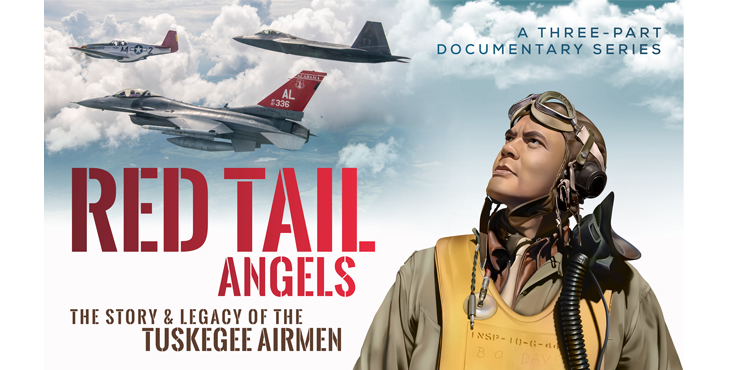Black History Month is a chance to celebrate and honor Black Americans who trailblazed paths for future generations. Among those trailblazers are the Tuskegee Airmen.
The 99th Pursuit Squadron activated March 23, 1941, in Tuskegee, Alabama. The Tuskegee Experiment was the first of its kind, producing an all Black unit to fight during World War II. Tuskegee graduated its first five U.S. Army Air Forces fighter pilots March 7, 1942, and more soon followed.
In late 2020, the Air Force produced a three episode series called “Red Tail Angels” to tell their story.
Episode 1 (27:41 run time)
Episode 1 dives into the history of the 16,000 men and women who became pilots, mechanics and support Airmen. An Army War College study said Blacks should not work in technical jobs, which was used to discriminate against them. President Franklin D. Roosevelt signed Public Law 18 April 3, 1939, which mandated the Army Air Corps expand its civilian pilot training program to Black colleges, paving the way for Black citizens to serve. Due to the need for pilots – and lobbying from Tuskegee Institute (now Tuskegee University) President Dr. Frederick Patterson – Black pilots started training.
Charles “Chief” Anderson became the lead instructor at Tuskegee. Known as the father of Black aviation, Anderson piloted First Lady Eleanor Roosevelt, helping to showcase abilities of Black pilots.
Air Force Veteran Charles McGee said Tuskegee Airmen could’ve given up because of discrimination, but they didn’t because “that’s not the American way.”
Air Force Veteran Charlynda Scales said she escorted a Tuskegee Airman who gave her advice on the legacy of Black service members.
“To listen to him talk about it and to tell me that uniform you wear, there are so many people that have sacrificed and lost their lives and paved the way for this to happen and to not take that lightly,” she said. “He was a part of the village that raised me as a service member and now as a Veteran.”
Although operational, the 99th Fighter Squadron didn’t get into the war immediately. That changed when Col. Noel Parrish went to Washington.
Episode 2 (23:56 run time)
Episode 2 tells about Air Force Veteran Benjamin O. Davis, a 1936 West Point graduate. Davis applied to flight training, but did not receive a slot because of the military’s discrimination toward Black officers. Instead, he became one of the first five Tuskegee pilot graduates in March 1942.
“He was one of the finest men I’ve ever met in my life,” Air Force Veteran Harold Brown said. “The fact that we were as successful as we were, he really prepared us for that transition.”
Davis led the 99th Pursuit Squadron into their first deployment. Flying Curtis P-40 Warhawks, they attached to the all-white 33rd Fighter Group at Fordjouna, Tunisia, in spring 1943. On June 2, 1943, the 99th saw its first combat as the Allies secured the Italian island of Pantellaria. On July 2, the unit scored its first aerial victory against the Luftwaffe when 1st Lt. Charles B. Hall shot down a Focke-Wulf Fw 190 on his eighth mission. He was the first Black pilot to shoot down an enemy aircraft.
Despite its early success, Davis had to justify the continued existence of the 99th. After fending off attacks from military leaders, the pilots started flying bomber escort missions under 15th Air Force.
When Davis briefed pilots, he told them to stay with the bombers and never leave, Brown said. Instead of chasing personal accolades, the 99th protected bomber crews, which carried 12-15 men aboard. Bomber crews started requesting the 99th, known as the Red Tail Angels, due to the distinctive color on their tails.
Episode 3 (30:14 runtime)
In the final episode, the 477th Bombardment Group fought against racism at home in the Freeman Field Mutiny in Indiana. Unable to use clubs, swimming pools or movie theaters, 101 Black officers attempted to enter the Officers Club. They faced punishment ranging from written reprimands to death by firing squad.
Three faced a court martial. The military dismissed two cases. The third, against Tuskegee Airman Roger Terry, went to trial, ending in a guilty verdict.
Despite fighting two wars against the Germans and racism, Tuskegee Airmen posted an impressive record. They flew 312 missions for 15th Air Force, 179 of these bomber escort missions. Only seven missions suffered losses, with 27 bombers shot down. In comparison, other units had an average 46. They also scored 112 aerial victories, with three pilots shooting down four aircraft each, one short of ace status.
Returning back to the U.S., these Veterans did not receive the same level of respect as other combat Veterans. Instead, they returned to segregation. However, they paved the path for future generation of Black military members.
“They proved the stereotypes weren’t true,” said Air Force Veteran Darren McDew.
Decades after blazing the path, the group received a Congressional Gold Medal. The vote in the House and Senate was unanimous.
“It’s not often you get the chance to meet the guys who have paved the path for you,” said then-President George W. Bush, himself an Air Force Veteran. “The Tuskegee Airmen helped win a war, and you helped change our nation for the better. Yours is the story of the human spirit, and it ends like all great stories do, with wisdom and lessons and hope for tomorrow. And, the medal that we confer today means that we’re doing a small part to ensure that your story will be told and honored for generations to come.”
Bush ended his speech by offering a salute to the Tuskegee Airmen for their bravery.
Topics in this story
More Stories
Over the five-year program, more than 14,000 VET TEC beneficiaries completed their program and nearly half have reported finding meaningful employment with an average starting annual salary of $65,000.
VA is calling for applicants for the 2024 Specially Adapted Housing Assistive Technology grant.
Updated COVID vaccines are available free of charge to Veterans receiving care at VA .







The DOTA shown at the very end of Documentary Series III was Army Air Corps SSgt/Flight Chief (deceased) Leslie Edwards, Jr. a Documented Original Tuskegee Airmen (DOTA) of the 617th Bombardment Squadron. He arrived for the 477th Fighter Group’s 10th Anniversary Commemoration at Joint Base Elmendorf-Richardson, Alaska, on 15 October 2017. His identification wasn’t listed along with other DOTA participants in the video. All three You Tube videos were excellent and very informative in regards to the ‘true’ history of our famed Tuskegee Airmen.
In 2007, the 477th Bombardment Group became the 477th Fighter Group, bringing with it the legacy of the Tuskegee Airmen to Alaska. This statement, fact, should be included with J. Covington Comment of March 8, 2021 at 6:48 pm.
“Thank you” to Ms Jacqueline Covington, volunteer and Ambassador for the Red Tail Squadron for her articles, etc., on bringing their inspirational story too light. These brave men from the “Greatest Generation” should never be forgotten. They were then and continue to be “treasures” in American History….
Awesome article! These gentlemen should be held in high regard.
I am currently a pilot working for the VA. Thanks for all this information because of the Tuskegee Airmen I can now obtain my pilot license and pursed a career in aviation.
F. Johnson
Our people have given their ALL to this country, my prayer is that fellow Americans realize the enormity of that contribution and treat Black Americans with more equity and kindness!!
it ‘s great to read about these outstanding men who put their lives on the line for a country that treated them as inferior. this country should be proud of them and the courage they showed in the face of the treatment they received.
I am a member of the Waterman/Twining Chapter of the Air Force Association. I’m proud that we here in Florida have a “Red Tail” Chapter to honor the Tuskegee Airmen.
Dennis E. Foley, Lt Col, USAF (ret)
I’m a retired (Major) Air Force and Vietnam Veteran. Colonel Hannibal Maceo Cox WW II Tuskegee Airmen was my Professor of Aerospace Science – at Tennessee State University. He gave me my first flying lesson in a Cessna 172. Tuskegee Airmen heroes as Generals Benjamin O Davis Jr and Daniel “Chappie”James helped shape and “kick start” my military career. They taught in AFROTC true meaning of “Duty, Honor, Country, Democracy, and the Human Call/Price/Cost Fighting for Freedom and Justice.” Regretfully there’s still racism in the ranks from top down and bottom up!!
My dad was a Tuskegee airman and I was born at Tuskegee. My dad, Arthur Williams started as a mechanic and after OCS went on to retire as a Colonel O-6.
I served as an Army officer in Korea, Vietnam and Germany.
General DISNEY was at my dad’s funeral at Arlington with about 20 other Tuskegee airmen. Over the years, I’ve had the honor of meeting many of these great people and their families.
I was a ground crew armorer for the 2nd Bomb Group servicing B-17s at our base outside Foggia, Italy, for some
17 months in ’44 and ’45. I recall how excited our air crews were when they learned that the Tuskegees were to
fly escort on a mission. I believe this was common through out the Fifteenth Air Force. Working together to constant
bombings of the Ploesti oil refineries may well have helped shorten the war in Europe.
GREAT!
I love the black aviators , and also note — The Triple Nickles – the world’s first black paratroopers ,the 555th , please watch – Nickles From Heaven – and remember black history is American history !!! Thank you , I was in actual combat in 1965 with 82nd airborne division ,I’m from Chicago Illinois
Awesome!
This a necessary requirement for all students in school and those studying history for social benefit as well as personal growth for all who are familiar with the history of the Tuskegee Airmen. I have personally met one of the men, “Rip” Harder, and it was greatly appreciated. It was accidental but greatly appreciated by myself and my wife. the stories he shared were amazing.
James M. Wells, Jr, Coarsegold, CA
Veteran
USAF
My wife’s dad was also a WWII veteran and so were my father and his brothers.
Thank you.
it was an honor and privilege to meet & listen to one of the surviving airmen Feb 1997 at Squadron Officer School – class 96B, Flight F62!
Its not cool how to this day it is considered an experiment. That was the mindset of them back then. At this point it should be considered more as aviation training. Giving syphilis was an experiment, and a horrible one at that. This was simply training men to fly and fight and defend. They succeeded in training which opened the door for more to be considered. It also opened the narrow minds of the folks in that time period. So I see it offensive because these men were not subjects, they were men. Airmen who served honorably and protected those who even considered them inferior as men. We can honor them better with our words. Just my opinion.